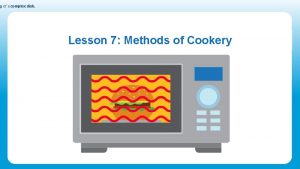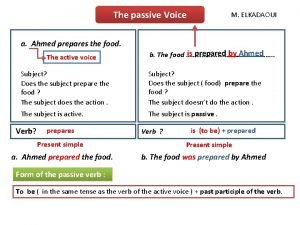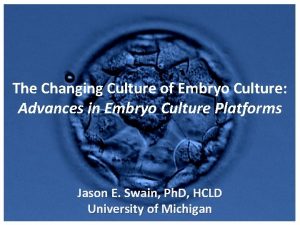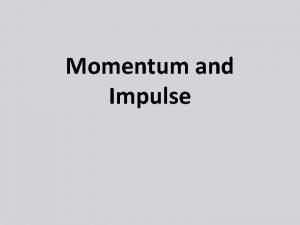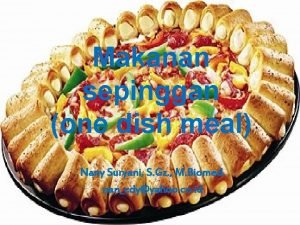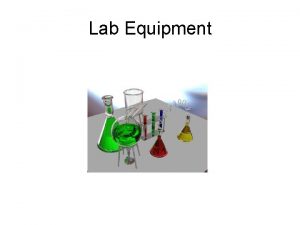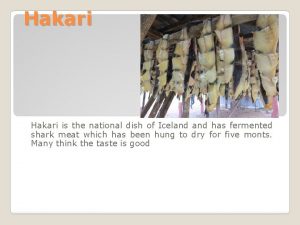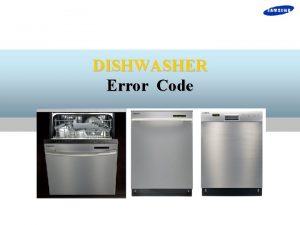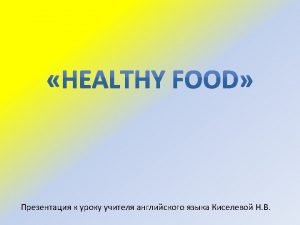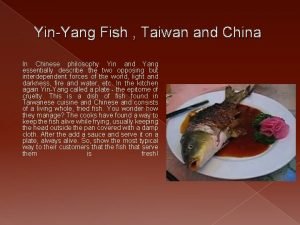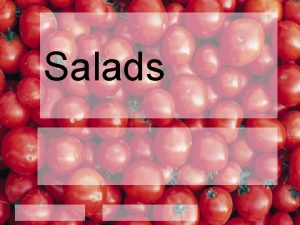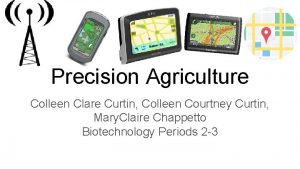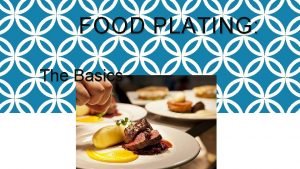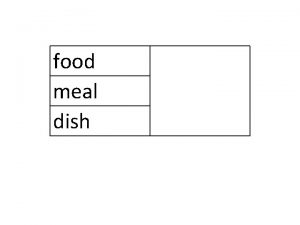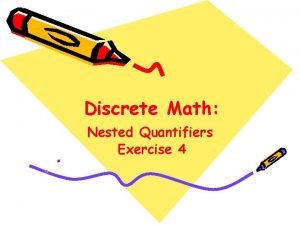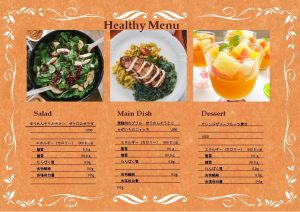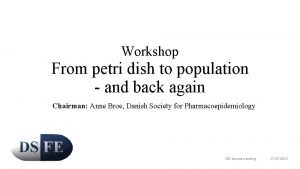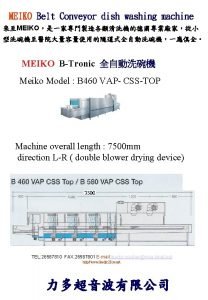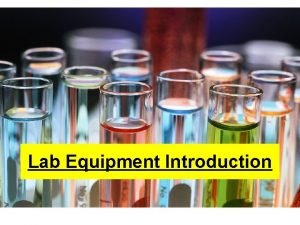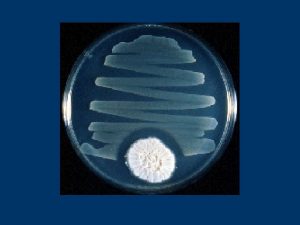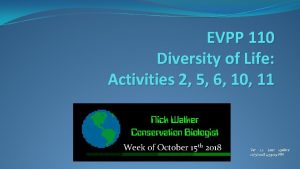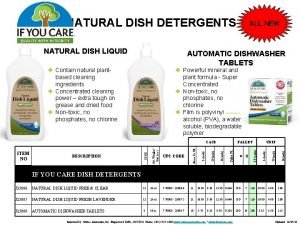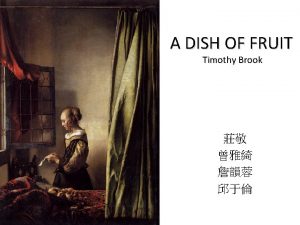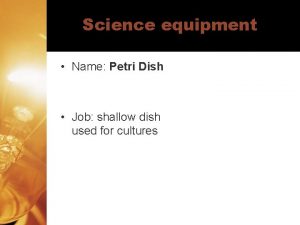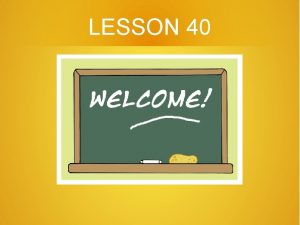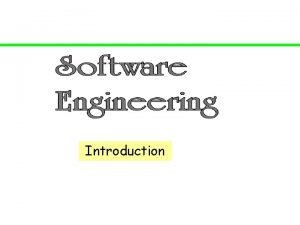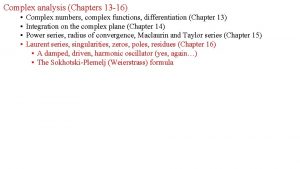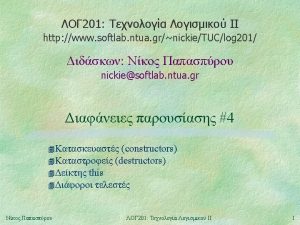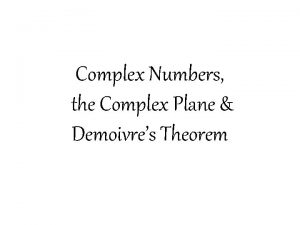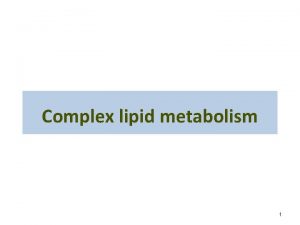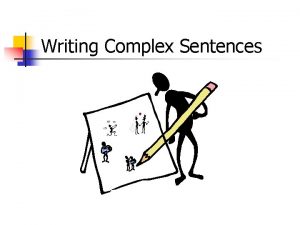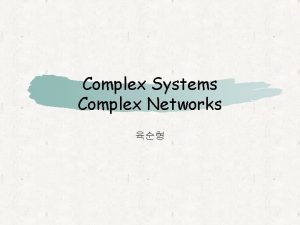g of a complex dish Lesson 7 Methods








































- Slides: 40

g of a complex dish. Lesson 7: Methods of Cookery

g of a complex dish. To show progress today I should … Be able to explain the different methods of cooking food and suggest ingredients they can be used for. Edible: fit to be eaten Lesson Plan Be able to examine how the sensory properties and nutrition of food changes when cooked by different methods. Palatable: pleasant to taste Chemical reaction: the transformation of one set of chemical substances to another Be able to apply this knowledge to the cooking of complex dish. Toxin: a poisonous substance that is produced by living cells or organisms Nutritional value: nutritional content of a food or what the food is made up of. Food poisoning: illness caused by bacteria or toxins in food

g of a complex dish. Effects of Heat on Food • Proteins coagulate - setting • Starches gelatinise - digestibility • Sugars caramelise - flavour • Water evaporates - flavours concentrate • Fats melt - mouth feel • Surfaces brown - mailliard reaction

g of a complex dish. Different Methods of Cooking Can be split into 4 categories: Dry – uses dry heat to transfer heat energy Moist – uses liquid to transfer heat energy Oil – uses oil to transfer heat energy Other – uses other methods

g of a complex dish. What methods of cookery have been applied to create this dish?

g of a complex dish. Different Methods of Cooking Identify and categorise the methods of cooking below: Method: ______________ Type: _________________ Method: _______ Type: _________ Method: ________ Type: __________ Method: _________ Type: ___________ Method: _______ Type: ________ Method: ___________ Type: _____________ Method: ______________ Type: _________________ Method: _______ Type: _________

g of a complex dish. Different Methods of Cooking Identify and categorise the methods of cooking below: Method: Steaming Type: Moist Method: Barbeque Type: Dry Method: Stir Frying Type: Oil Method: Deep Fat Frying Type: Oil Method: Stewing Type: Moist Method: Roasting Type: Dry Method: Boiling Type: Moist Method: Grilling Type: Dry Method: Toasting Type: Dry Method: Baking Type: Dry

g of a complex dish. Key reasons for cooking • Safety • Destroys harmful bacteria in foods • What temperature should high risk food reach? • Destroys natural poisons – e. g. kidney beans • Digestibility • Makes food softer to eat • Starch • Edibility • Makes food more appealing to eat • Colour, texture, aroma, flavour • Give variety • Enables foods to rise, be thickened, dissolved and set

g of a complex dish. Scientific principles underlying the preparation and cooking of food What will I learn? • The reasons why food is cooked • The heat transfer methods that can be used to cook food Have you ever eaten a raw potato? The answer is likely to be no. The reason being is that potatoes should be cooked before being eaten for a number of reasons; • • To add flavour to food To change the texture of the food To change the appearance of the food To change the aroma of the food To make the food easier to digest To make the food safe to consume To minimise food spoilage

g of a complex dish. Scientific principles underlying the preparation and cooking of food Cooking the potato changes its taste making it more edible or palatable. This change in taste happens because of chemical reactions that occur during the cooking process. present in raw potatoes, heating the potatoes to a high enough temperature (66°C) changes the starch molecules and making it digestible. Without cooking we would be unable to These reactions can also have an effect gain nutrients from potatoes and we on the foods appearance, texture and would be unlikely to eat them. Therefore aroma making them more likely to be cooking also increases the range of food eaten. Due to these chemical reactions that we eat. the food is also easier to digest. Our body cannot digest the starch

g of a complex dish. Scientific principles underlying the preparation and cooking of food Kidney beans are another example of foods that must be cooked before being eaten. The raw kidney bean contains high levels of a toxin called Phytohemagglutnin, which if eaten cause nausea, vomiting and diarrhoea. Cooking reduces the toxin levels, making the kidney bean safe to eat. Cooking food also reduces the risk food poisoning. Food poisoning is caused when a person eats food that is contaminated with bacteria such as salmonella, e-coli and campylobacter. Cooking food to 75°C destroys any bacteria present. You can test that food is at the correct temperature using a temperature probe. The temperature should always be taken from the centre of the food. Destroying bacteria and other microorganisms such as fungi slows down the process of decay. This means that the food will last longer if stored correctly.

g of a complex dish. Task … Produce a leaflet that could be used to inform new chefs about the importance of cooking food. Key points • Food is cooked to add flavour, change the texture, appearance, aroma, make it easier to digest, safe to consume and to minimise spoilage. • Some food may be contaminated with food poisoning causing micro-organisms that are destroyed by cooking. • Some food contain toxins that are destroyed by cooking. • Killing food spoiling bacteria slows down decay. Edible: fit to be eaten Palatable: pleasant to taste Toxin: a poisonous substance that is produced by living cells or organisms Chemical reaction: the transformation of one set of chemical substances to another Food poisoning: illness caused by bacteria or toxins in food

g of a complex dish. 1. 2. 3. 4. 5. Test yourself List seven reasons why food should be cooked. What is the main reason we cook chicken rather than eating it raw? What is meant by the term palatable? Name 3 bacteria that can cause food poisoning Food has been sent to a customer that is cold. How could the chef have prevented this?

g of a complex dish. How can food be cooked? Convection is used in many situations, for example boiling eggs in a pan. The stove is a source of heat energy which heats the bottom of the pan. The water molecules closest to the bottom of the pan will gain kinetic (movement) energy and spread out. This means that this area of water will become less dense and rise. The cooler water at the top of the pan moves down to take its place. This causes a convection current, the boiled water circulates around the food, cooking it. Other liquids such as oil can be used in the same way, this method of cookery is known as deep frying. Another way to use convection is cooking food in an oven. Here gases are heated rather than liquids, the principles are the same however. Many modern day ovens have a fan to assist the circulation of the air flow to enable a fast and more reliable method of cookery.

g of a complex dish. Convection Experiment What will I need? • 1 clear bowl • Warm water • 1 tbsp. red food colouring • Ice cubes made with blue food colouring 1. Add the warm water into the clear bowl 2. At one end of the bowl, add the blue ice cubes 3. Next add the red food colouring at the opposite side of the bowl Observe what happens inside of the bowl. How is this linked to convection?

g of a complex dish. How can food be cooked? Conduction During conduction heat energy is passed to the food from the heat source by direct contact e. g. frying bacon. In kitchens most pans are made of stainless steel or cooper as these are excellent conductors of heat. Poor conductors are plastics and wood. Most stirring appliances such as wooden spoons and spatulas are made for this reason, making it safer when stirring the food. Heat energy is transferred from the hob to the outside of the pan, the molecules will begin to vibrate and pass on this energy to any other molecules they are in contact with. The heat energy is passed from the hotter part of the pan to the Many chefs like to cook meat and fish with the bone colder part of the pan. attached. The bone conducts heat energy so the centre of the meat or fish is cooked more quickly Food that comes into contact with the inside of the and evenly. pan will also gain this energy.

g of a complex dish. Conduction Experiment What will I need? • A candle • 2 water balloons • Tongs • A beaker of water Explanation: The candle is warming the water rather 1. Light the candle than popping the balloon. That’s why 2. Blow up the first balloon and tie 3. Using the tongs slowly move the balloon towardseverywhere. the flame water isn’t goingdown flying The 4. Next fill the second balloon with 50 ml of water, blow it up and tie. 5. Repeat step 3. balloon conducts heat and is able to it to the without damaging Using what you transfer know about conduction can water you explain why one balloon burst and the other did not? the balloon.

g of a complex dish. How can food be cooked? Radiation All warm objects give off infra-red radiation that travels as waves. Food that is cooked by grilling or toasting is cooked by radiation. The grill gives off infrared radiation which is absorbed by the food increasing its temperature. Microwaves use a different type radiation to cook food. The radiation is high-energy radio waves given the name microwaves. The microwaves penetrate the food and are absorbed by the water in the food, causing the molecules to vibrate, increasing its temperature. This heat energy cooks the food. The radiation in a microwave is not produced evenly which is why microwaves have turntables to rotate the food.

g of a complex dish. Radiation Experiment What I will need? • 8 slices of buttered bread • A plate • A microwave 1. Place four slices of buttered bread onto the plate 2. Place into the microwave and cook for 15 -30 seconds 3. Repeat steps 1 and 2 without the turntable. 4. Compare the way in which the butter has been melted with and without the turntable. Most cooking methods combine at least two heat transfer methods. Barbecuing for example combines all three as heat energy is transferred to the food convection currents in the air, by infra-red radiation from the hot coal and by the grill that the food sits upon.

g of a complex dish. Activity Visit your school canteen or a local restaurant and investigate the dishes. How many different methods of heat transfer and cookery can you identify? Key points • Food is can be heated using three types of heat transfer; convection, conduction and radiation • Convection occurs in a liquid or a gas • Conduction occurs in a solid or a liquid • Food can be cooked by infrared radiation • Most cookery methods combine heat transfer methods Convection: transfer of heat energy through a liquid or gas Conduction: transfer of heat energy through a solid or liquid Radiation: transfer of heat by waves

g of a complex dish. Test yourself 1. Name the heat transfer methods used to cook food. 2. Which heat transfer methods are used when: a) Boiling an egg b) Frying bacon c) Toasting bread 3. A chef places a skewer through his jacket potatoes before cooking them. Suggest how this speeds up the cooking process. 4. Compare and contrast the 3 heat transfer methods.

g of a complex dish. Make food safe to eat Foods such as meat, fish and shellfish must be thoroughly cooked, these are called high risk foods. High risk foods need cooking above 75 degrees Why is this?

g of a complex dish. Some foods contain natural toxins when raw. Cooking destroys the toxins and makes the food safe to eat Raw kidney beans must be cooked in boiling water for at least 15 minutes to remove the harmful enzyme Potatoes need cooking completely as the body struggles to digest the starch, this can lead to an upset stomach

g of a complex dish. To develop flavours in food – chemical reactions take place Cakes – fat melts, proteins in eggs and flour coagulate, sugars caramelise, starch gelatinises Meat stew – vegetables soften and cook, meat protein coagulates, meat juices are squeezed out (extractives), meat flavour develops as proteins tenderise.

g of a complex dish. Quiche Flavours from each filling ingredient combine with egg and milk, egg protein sets, cheese melts and develops a well-flavoured layer on top.

g of a complex dish. Cooking concentrates and intensifies flavour and thickens a dish by causing water to evaporate

g of a complex dish. To improve texture and appearance – easier to eat, swallow and digest Cooking causes starch granules to swell, gelatinise and thicken or soften a food

g of a complex dish. Cooking tenderises meat making it softer and easy to chew and digest To improve texture and appearance – easier to eat, swallow and digest

g of a complex dish. To improve texture and appearance – easier to eat, swallow and digest Cooking melts fat and gives a smooth “mouth-feel”.

g of a complex dish. To improve texture and appearance – easier to eat, swallow and digest Cooking softens the structure of cells in vegetables to make them less bulky and easier to eat

g of a complex dish. To improve texture and appearance – easier to eat, swallow and digest Cooking turns raw dough into risen, light-textures and crusty bread and bun products

g of a complex dish. To improve texture and appearance – easier to eat, swallow and digest Cooking develops a crisp texture on the outside of some foods

g of a complex dish. To improve its shelf-life Cooking destroys harmful micro-organisms which preserves the food

g of a complex dish. Test yourself • 1. What happens to starch in rice, pasta and peas when boiled? • 2. What method of cooking uses high temperatures, a little oil and retains the crunchy texture of vegetables • 3. What do vegetables lose if cooked in liquid? • 4. What 3 things do steamed vegetables retain? • 5. What happens to the flavour of vegetables such as parsnips and carrots when cooked?

g of a complex dish. Test yourself • 6. What happens during cooking that affects the texture of vegetables? • 7. What happens to vegetables when roasted? • 8. Why should meat and poultry not be overcooked when roasting? • 9. What happens to foods containing raising agents when baked? • 10. Why is stir frying considered a healthy cooking method?

g of a complex dish. Test yourself • 11. Why do onions, parsnips, carrots and potatoes go brown when shallow fried? • 12. Why does flavour intensify in vegetables that are sautéed? • 13. What happens to vitamins C, B 1 and B 2 when cooked at high heat such as frying, roasting etc? • 14. What happens to the protein in meat and poultry when exposed to any form of heat? • 15. Why does meat become more tender when cooked slowly e. g. braising and stewing?

g of a complex dish. Test yourself • 16. Why are foods cooked in flavoured liquids such as stocks? • 17. What happens to the alcohol produced by fermentation of bread dough, when baked in the oven? • 18. What happens to starch when foods are toasted?

g of a complex dish. Cooking Methods Answer sheet 1 • Gelatinise 2 • Stir frying 3 4 • Water soluble vitamins • Colour, crunch, water dissolve into the soluble vitamins cooking liquid – carotene, vit C and Bs 5 • Flavour intensifies – become sweeter 6 • Softens and tenderises 7 • Shrink, water evaporates, crisp outer, caramelise 8 • Become dry and less digestible 9 • Raising agents expand, food rises in the oven and sets, develop a tender open crumbly spongy texture 10 • Minimises loss of bgroup vits and vit C, little oil used so energy density low 11 • Caramelisation 12 • Water evaporates and concentrates the flavour 13 • They are affected and can be damaged 14 • Denatures and coagulates, causing meat/poultry to shrink 15 • Collagen turns to gelatin 16. The flavour of the stock is absorbed into the foods whilst cooking 17 • It evaporates 18 • Turns to dextrinisation

g of a complex dish. More Experiments: 1) Take 2 glasses of water and add a tablespoon of caster sugar to one, and a tablespoon of granulated to the other and stir. What has happened? Next place the granulated glass in to the microwave for 30 seconds and stir, what happens? 2) Place a rasher of bacon on a tray under the grill and cook until golden. Once cooked remove the tray and examine the rendered fat. Drain the fat into a plate and allow this to cool. Examine the fat once cool. 3) Place strong bread flour into a muslin cloth and wash the cloth under gentle running water until the water is clear when the cloth is squeezed. To test the starch levels add a little iodine (mixture will turn black if starch is present). Next make a bread roll using the mixture. Bake the mixture and examine the results. What did you find? Key points • It is important to choose the correct cookery method depending upon the expected outcome. • Food can be cooked with water, dry heat and fat based cookery, using a grill or using an oven. • Methods of cookery using oil generally make the food less healthy. • The nutritional value of foods such as vegetables is affected by some cookery methods. Nutritional value: nutritional content of a food or what the food is made up of.

g of a complex dish. Test yourself 1. State the possible cookery methods you could use if you wanted to: a. Cooked eggs gently without the shell b. Melt cheese on a jacket potato c. Cook meat so that is was rare d. Cook batter until crisp 2. Which nutrient is most affected by the cooking process? Exam practice questions: 1. Describe how you could cook food to prevent food poisoning. (2 marks) 2. Food should be cooked to prevent food poisoning. Give three other reasons. (3 marks) 3. Describe three heat transfer methods used to cook food (6 marks)
 Convection experiment
Convection experiment Simple compound complex and compound-complex sentences quiz
Simple compound complex and compound-complex sentences quiz Ghon complex and ranke complex
Ghon complex and ranke complex Simple, compound complex rules
Simple, compound complex rules Electra complex vs oedipus complex
Electra complex vs oedipus complex Psychoanalytic theory defense mechanisms
Psychoanalytic theory defense mechanisms Uniquisitive
Uniquisitive Indirect methods of contoring uses how many methods
Indirect methods of contoring uses how many methods Active and passive chart
Active and passive chart Embryo slide culture dish
Embryo slide culture dish Plurals examples
Plurals examples When a dish falls will the impulse be less
When a dish falls will the impulse be less Hamburger termasuk makanan sepinggan
Hamburger termasuk makanan sepinggan What is an evaporating dish used for
What is an evaporating dish used for Hakari dish
Hakari dish Model name
Model name Rocket burrito billings mt
Rocket burrito billings mt 18008330016
18008330016 Pickck
Pickck Solving momentum
Solving momentum Dish tv complaint email id ceo
Dish tv complaint email id ceo 10 cm dish surface area
10 cm dish surface area How to answer what's your favorite food
How to answer what's your favorite food Chapylines
Chapylines Dish salters
Dish salters 4 types of salad
4 types of salad Dish curtin
Dish curtin Plating
Plating Food meal dish exercises
Food meal dish exercises Smrthub
Smrthub Dish new madrid
Dish new madrid Let t(x y) mean that student x likes dish y
Let t(x y) mean that student x likes dish y Virgilio matheus
Virgilio matheus Sheep plural
Sheep plural Healthy main course menu
Healthy main course menu Satrover dish
Satrover dish What is a petri dish
What is a petri dish Conveyor belt dishwasher
Conveyor belt dishwasher Function of beakers
Function of beakers Fleming petri dish
Fleming petri dish Specimen dish
Specimen dish
